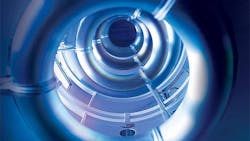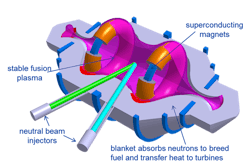So far, the efforts to feed our seemingly insatiable appetite for energy have all been massive operations – windmill farms towering across the countryside, solar arrays the size of football fields, nuclear and coal plants lurking at cities' edges.
But a new project coming out of the Skunk Works team at Lockheed Martin (IW 500/30) is taking a different approach. A radically different approach.
Today, the team announced progress made on a compact fusion reactor (CFR) that packs the same power capacity of those large-scale systems into a device small enough to fit on the back of truck.
Potential applications for the device are endless – from interplanetary spacecraft and city power stations to nuclear-powered aircraft that can fly practically forever without refueling.
If it works out, it could basically answer all of our global power needs and effectively end our dependence on fossil fuels. It has already been called the "holy grail" energy breakthrough we've been waiting for.
Those are all big claims, of course, but after 60 years of work, this project is suddenly starting to seem like a pretty big deal.
CFR Details
Basically, the CFR is straight out of a comic book villain's lab.
It uses a system of high-powered electromagnets to hold together a mass of plasma reaching millions of degrees, roiling at the heart of the device.
There, superheated deuterium (produced from sea water) and tritium (derived from simple lithium) fuse together, producing energy 100 times more powerful than chemical reactions and three-to-four times stronger than the fusion reactions that drive our current nuclear power facilities.
It is basically a pint-sized steel sun that (once completed) will be ready to power our cities, power our ships and planes, charge our cars and light our homes.
The fuel is said to be effectively inexhaustible and its waste deemed safe after just 100 years (a heartbeat compared to what fission reactors throw off).
A viable prototype of the CFR is still about five years away, Lockheed researchers say, and the devices are still probably a decade from actual deployment.
But with the technological breakthrough this project represents, that timeline seems almost frighteningly fast.
Read the full breakdown of the CFR project and its Skunk Works on Aviation Week: Skunk Works Reveals Compact Fusion Reactor Details
About the Author
Travis M. Hessman
Editor-in-Chief
Travis Hessman is the editor-in-chief and senior content director for IndustryWeek and New Equipment Digest. He began his career as an intern at IndustryWeek in 2001 and later served as IW's technology and innovation editor. Today, he combines his experience as an educator, a writer, and a journalist to help address some of the most significant challenges in the manufacturing industry, with a particular focus on leadership, training, and the technologies of smart manufacturing.

